Schedule a Call
Get started with your organic growth journey!



Get insights on AI, productivity, and the future of work.



As a demolition contractor, your success depends on being visible when potential clients are ready to act.
From tearing down old houses to clearing construction sites or handling commercial renovations, people search for demolition services when they need them most. If your business isn't showing up in those searches, you're missing the opportunity to connect with clients who truly need your expertise.
SEO for demolition contractors ensures your business is visible when clients are searching, allowing you to focus on delivering top-quality results.
SEO, or Search Engine Optimization, is the practice of making your demolition business easier to find online when potential clients search for services you offer. It’s about connecting with people actively seeking your expertise.
Why It Matters:

Here’s how:
Now that we understand why SEO is vital, let's explore the core strategies that can make it work effectively for your demolition business.
The right SEO strategies are crucial to ensure your demolition business is visible to local clients when they need your services. From optimizing local profiles to structuring your website with targeted content, these strategies will help drive relevant traffic and build long-term visibility.
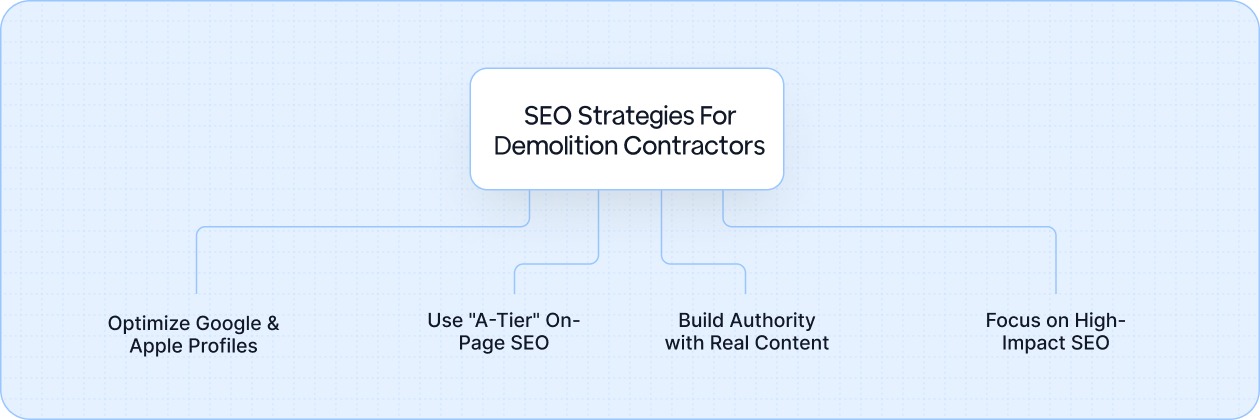
Let’s dive into the key actions that will make SEO work for you.
Your Google Business Profile and Apple Business Connect are vital to being found by local clients. These profiles directly influence how your business shows up in search results, especially in the local “Map Pack.” Without optimized profiles, your business could be invisible when people need your services most.

Optimizing your website’s on-page elements allows both users and search engines to understand exactly what services you offer and where. This is essential for targeting local customers actively searching for demolition services.

Google values authenticity; real content that connects with the local community improves your SEO. Share your team’s story, customer success, and local partnerships to position yourself as the go-to expert.

There are a lot of low-impact SEO tactics that can waste time without providing results. Geotagging images and social media activity may seem helpful, but they don't contribute to your rankings. Instead, focus on strategies that truly matter.
Must Read: Get Noticed or Get Overlooked: The Ultimate SEO Guide for Contractors
Positive customer reviews and effective internal linking are essential strategies for improving your SEO. Reviews enhance your local visibility and build trust, while internal links strengthen your site’s structure and relevance.
Together, they help ensure your business stands out in search results and connects with the right clients.
Customer reviews directly impact your local SEO. Positive reviews attract potential clients and signal to search engines that your business is credible and relevant.
Google values customer feedback, making it a powerful tool to help you rise in local search results. Engaging with your customers through reviews also strengthens your online presence and credibility.

Internal linking connects the dots between different pages on your site, helping search engines and users navigate it more effectively. This strategy strengthens your website’s structure, making it easier for search engines to determine the relevance and relationship between your content.
Additionally, it helps keep visitors engaged, guiding them from one page to another in a logical flow.

Website performance plays a crucial role in both user experience and search engine visibility. Fast loading times and a mobile-friendly design ensure your visitors stay engaged and help improve your rankings.
Let’s dive into how optimizing these aspects can directly impact your demolition business’s online presence.
Website speed directly impacts how users experience your business. Google prioritizes fast-loading sites because they provide a better experience for users, leading to higher engagement and lower bounce rates.
A slow website can frustrate visitors and make them leave, while a fast one keeps them on your site longer, signaling to Google that your content is valuable. Faster sites retain users longer and increase the likelihood of conversions, improving both user experience and SEO.

More clients are searching for demolition services on mobile devices than ever before. In fact, mobile-first indexing means that Google now prioritizes the mobile version of your website for ranking. If your site isn’t optimized for mobile, you risk losing valuable clients and missing out on better rankings.
Ensure that all your content displays correctly across all devices, from desktops to smartphones, to provide a seamless experience for users.
Must Read: Why Construction Companies That Master SEO Get More Projects: 8 Key Strategies to Get Started
Keyword research is the backbone of your SEO strategy, helping you connect with clients who are actively searching for your demolition services. By targeting the right, specific terms and long-tail keywords, you can attract highly qualified prospects and stay ahead of the competition.
Let’s explore how to identify and use the best keywords to get your business noticed.
Effective keyword research is the foundation of your SEO strategy. It requires understanding what your potential clients are actually searching for when they need demolition services.
By using tools like Google Keyword Planner or Ahrefs, you can uncover keywords that align with your audience’s search intent, allowing you to create content that answers their questions and meets their needs.
Client-Centric Search Terms: Focus on understanding the specific services your clients need, such as “emergency demolition services” or “green demolition contractors,” and target those terms.

Long-tail keywords are a goldmine for demolition businesses. These highly specific search terms, such as “licensed concrete demolition in Chicago” or “affordable house demolition,” may attract fewer searches, but they bring in more qualified prospects who are closer to hiring.
People searching for these specific services know exactly what they want, making them more likely to convert into clients.
Long-tail keywords help you cater to specific needs, reducing competition and increasing the chances of connecting with users ready to take action.

Backlinks and local citations are essential for strengthening your demolition business’s online authority. These elements improve your SEO by enhancing trust and relevance in local searches, ultimately driving visibility and engagement.
Let’s dive into how you can leverage these strategies to improve your presence.
Backlinks act as endorsements from other websites, helping search engines recognize your site’s value and authority. Focus on securing high-quality backlinks from local businesses, industry websites, and trusted directories. These connections improve your rankings and drive valuable traffic to your site.
A single backlink from a reputable local business or industry leader carries more weight than several links from lower-quality sources.
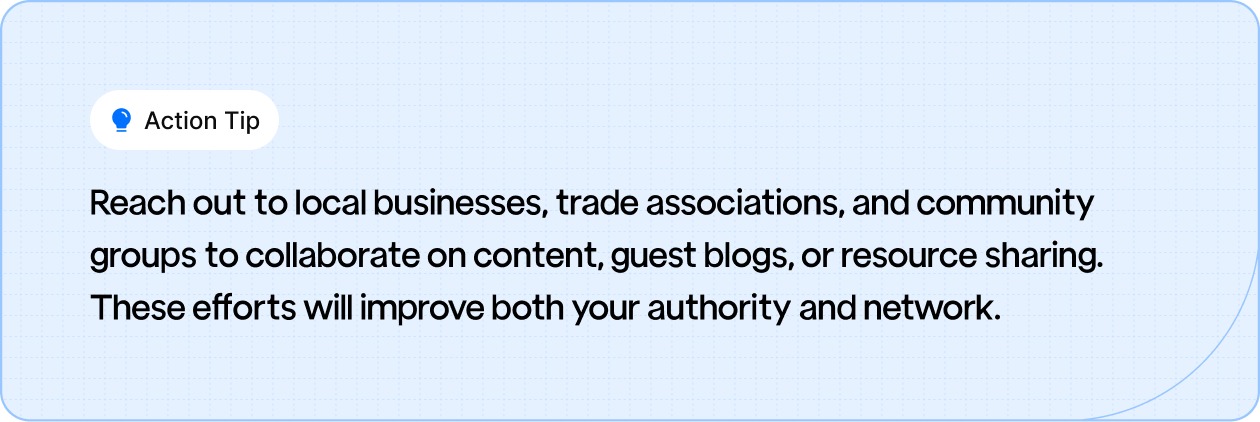
Local citations ensure your business information is accurate across various online directories, helping search engines confirm your location and credibility. Consistency in your NAP (Name, Address, Phone number) is essential for appearing in local search results. Inconsistent details can confuse search engines, harming your SEO.
Ensure your NAP details are the same across all directories to avoid penalties and enhance local search rankings.

Optimizing your demolition business’s website for smartphones is essential. A seamless mobile experience, coupled with a well-designed user interface, keeps visitors engaged and improves your chances of ranking higher in local searches.
Let’s explore how mobile optimization and user-friendly design can make your site stand out.
With a large portion of clients searching for demolition services directly on their phones, mobile optimization is critical. If your website isn’t responsive or loads slowly on mobile devices, potential clients may quickly abandon it and turn to competitors.
A mobile-optimized site ensures that your business appears trustworthy and accessible when clients need it most, no matter where they are. Google now uses mobile versions of websites for ranking purposes, making it crucial for your site to deliver a smooth mobile experience.
User experience is how easily and quickly visitors can navigate your site. A positive UX means users can find what they need without frustration, keeping them engaged and more likely to take action. This directly impacts your SEO, as Google prioritizes websites that provide clear, intuitive, and satisfying experiences.
An easy-to-use, clutter-free website with clear calls to action will keep users moving through your site and increase the likelihood of converting them into clients.
Suggested Read: Local SEO for Contractors: A Simple Guide to Get Noticed
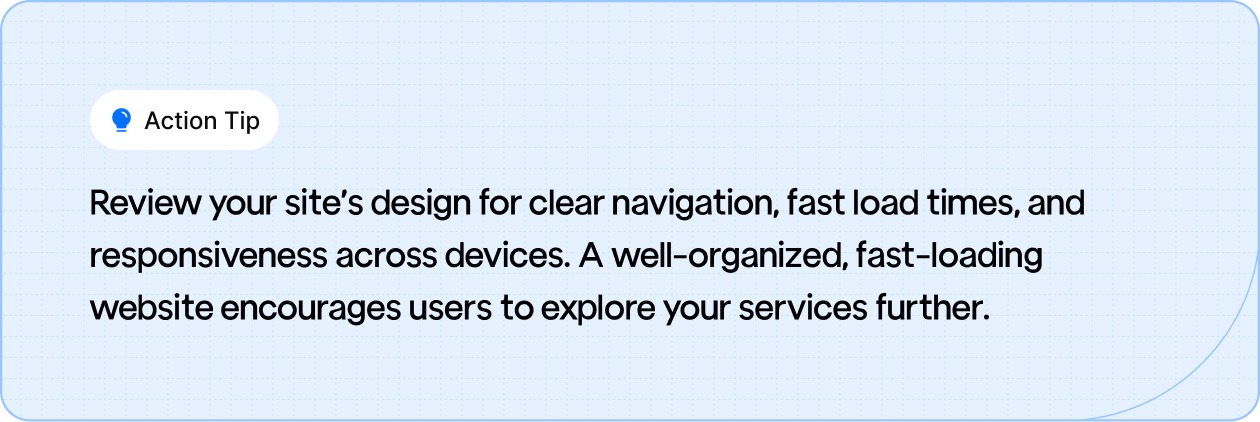
SEO for demolition contractors requires optimizing your website for local searches, creating structured and relevant content, building your online authority, and providing a seamless user experience that keeps clients engaged.
By focusing on these elements, you’ll improve your rankings and attract and convert more qualified leads.
If your business is ready to streamline its content strategy and improve its SEO, now is the time to take action and optimize your website for better visibility and results.

When someone searches for “lighting installation near me,” they’re looking for someone who can solve their immediate need with expertise and reliability.
But how will they find you if your business isn’t visible where it actually should be?
Local SEO for lighting installation helps you position your business exactly where your potential clients are looking, right in their neighborhood. It’s a chance to make your expertise the first thing they see when they need help the most.
Local SEO ensures your lighting installation business shows up when customers search for services nearby. It focuses on helping you optimize your online presence, so you appear in location-based searches like “LED lighting installation in Chicago” or “affordable lighting solutions near me.”
This targeted approach connects you directly with people in your area who need your services.
For lighting installers, being visible in local searches is essential. Most customers seek out businesses in their region.
Without local SEO, you risk losing potential customers to competitors in your area. By optimizing for local searches, you ensure that your business appears when it matters most.
A well-executed local SEO strategy increases your visibility and puts your business in front of customers who are already looking for services in your area. This leads to more inquiries and service calls, driving growth for your business.
Suggested Read: Landscape Lighting SEO: Strategies That Will Help Your Business Shine Bright in Search Results!
Local SEO is the key to making your lighting installation business visible to customers in your area when they need it most.

By optimizing your online presence across platforms like Google Business Profile and Apple Business Connect, and targeting location-specific keywords, you can ensure your business stands out in local search results and attracts more customers.
Your Google Business Profile is the cornerstone of your local SEO. If you haven’t claimed or optimized your GBP, you’re missing out on valuable opportunities to be discovered by local customers. Here’s how to make the most of it:
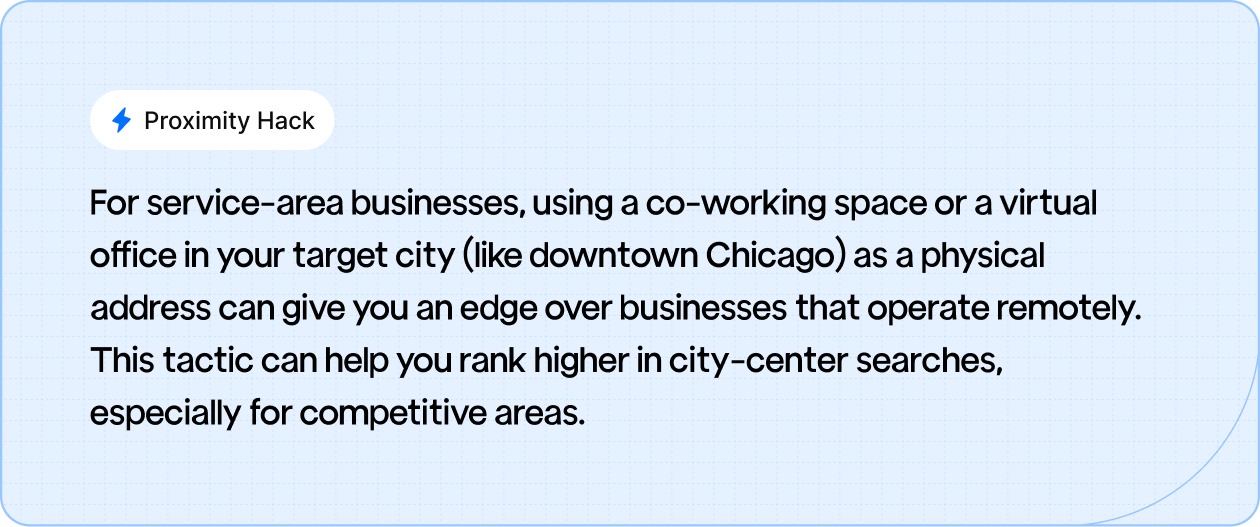
While Google leads the charge in search, Apple Maps is a major player, especially for iPhone users. Many potential customers will use Apple Maps to find nearby services, making Apple Business Connect a must for local SEO.
By leveraging Apple Business Connect, you’ll widen your local footprint, making it easier for iPhone users to find your lighting installation services.
To dominate local SEO, your website and content need to be personalized for the specific locations you serve. Using location-specific keywords is crucial for visibility in local searches.
Make sure that these keywords are used strategically across your website: in titles, meta descriptions, and service pages. This will help you appear in more relevant local searches, bringing in customers who are ready to act.
Must Read: Local SEO for Contractors: A Simple Guide to Get Noticed
Optimizing your website for local SEO is key to attracting nearby customers who are searching for lighting installation services.
By focusing on location-specific landing pages, on-page SEO, and site speed, you can significantly enhance your local visibility and drive more qualified traffic to your business.
To capture local customers, create location-specific landing pages. This makes your website more relevant for searches tied to specific areas, like “Lighting Installation in Chicago” or “LED Solutions in Lincoln Park.” Key elements to include:
This strategy helps search engines recognize your expertise in a specific area, increasing your chances of showing up in location-based searches.
Optimize your existing pages by adding location-specific keywords throughout:
This tells search engines you’re a go-to service provider in those locations, improving your chances of ranking for relevant local search queries.
A fast website leads to better user experience and higher SEO rankings. Here’s how to improve your site’s speed:
Faster load times lead to happier visitors and better search rankings.
Creating content personalized to your local audience is a powerful strategy for driving relevant traffic to your lighting installation business.
By focusing on local trends, showcasing real-world projects, and offering helpful resources, you can improve your visibility in local searches while building trust with potential customers.
Creating content around local topics is one of the most effective ways to drive targeted traffic. Instead of generic articles, dive into topics specific to your community and the lighting needs of residents or businesses. Here’s how:
This approach improves local search rankings and positions your business as the go-to resource for area-specific lighting expertise.
Nothing builds trust faster than real-world examples from your community. Showcasing local case studies and customer testimonials is a powerful way to demonstrate your expertise and reliability.
Local case studies and testimonials provide social proof and demonstrate that you have experience serving customers with similar needs in their area.
Establish your business as an authority by providing educational content that solves real problems. The more useful your content, the more likely it is to attract and engage local searchers.
Educational resources attract visitors and position your brand as an expert, creating long-term trust with your community.
Customer reviews and local citations play a pivotal role in your lighting installation business’s local SEO. By encouraging satisfied clients to leave reviews and ensuring your business is listed consistently across local directories, you can improve visibility, build trust, and improve your search rankings.
This section shows you how to leverage both to strengthen your local online presence.
Positive customer reviews are one of the most effective ways to improve your local SEO. When potential customers search for lighting services, they want reassurance that your business is trustworthy and reliable. That’s where reviews come in.
Set up an automated email or text campaign to request reviews shortly after completing a service. Ask for feedback when the customer’s satisfaction is at its peak.
A simple message like “We’d love to hear your feedback!” can go a long way in encouraging customers to leave positive reviews.
When your customers include photos with their reviews, it adds an extra layer of credibility. Google prioritizes reviews with images, so ask satisfied clients to snap a picture of their newly installed lighting.
This visual proof can help push their review to the top of search results and enhance your business’s trustworthiness.
Local citations are mentions of your business across the web, typically in directories or on local business sites. They play a crucial role in local SEO by signaling to Google that your business is active and credible in your geographic area.
Building strong, local partnerships can help your business earn high-quality backlinks, further improving your SEO efforts. Collaborate with businesses that share your audience, such as electricians, construction companies, or even local home improvement stores, to gain valuable backlinks to your site.
Must Read: Search Engine Optimization for Paving Companies: Why Some Businesses Show Up First?
Tracking your SEO progress is essential to ensure your efforts are driving results. By monitoring key metrics, evaluating insights from your Google Business Profile, and continuously refining your content and tactics, you can stay on top of your SEO game and adapt to ever-changing trends.
To gauge the success of your local SEO efforts, you need to track key metrics that give you real insight into your performance. Focus on:
By regularly monitoring these metrics, you can get a clear picture of how your SEO is impacting your business and make adjustments to stay on track.
Your Google Business Profile is a goldmine for understanding how local customers interact with your business online. The insights section in GBP reveals:
Regularly reviewing Google Business Profile insights lets you optimize your profile and adjust your strategy to better meet customer expectations.
SEO is an ongoing process of refinement. Here’s how to keep improving:
The key is to stay proactive, using data to fine-tune your SEO efforts for better results over time.

To take your local SEO to the next level, it’s crucial to embrace advanced tactics that go beyond the basics. From using social media to improve local visibility to staying on top of algorithm changes and partnering with local influencers to build credibility, these strategies will help you strengthen your presence in the local market and stand out from competitors.
Social media platforms are powerful tools for building local SEO, but they’re often underutilized for this purpose. Here’s how to use social media to drive more localized traffic and engagement:
Social media is a vital local SEO tool when used strategically to engage directly with your community.
Google's algorithm updates frequently, and staying informed about local search algorithm changes can keep your lighting installation business ahead of the competition. Here’s why staying updated is crucial:
You don’t have to track every update, but staying aware of the most impactful changes will help you remain competitive in local search results.
Building a local authority requires building relationships within your community. Local influencers can help amplify your SEO efforts by driving local traffic and building trust with your audience. Here’s how to tap into this strategy:
These partnerships give you exposure to a new, engaged audience while strengthening your brand’s presence in your community.
Suggested Read: Electrician SEO That Turns Your Website Into a Lead Machine
Elevating your local SEO requires a strategic, multi-faceted approach that goes beyond the basics. By actively engaging with social media to enhance local visibility, staying ahead of algorithm shifts to adapt your strategy, and building authentic relationships with local influencers to increase credibility, you can create a strong local presence.
These tactics will differentiate your business from the competition and drive meaningful, long-term growth in your community.
Implement these advanced strategies today and watch your lighting installation business shine brighter in local search results.

If you work in animal services, content is never the problem. There are always animals to care for, stories to tell, updates to share, and urgent needs to communicate. The real challenge is making all that content actually work together.
Most shelters, rescues, and animal service organizations post consistently, yet still struggle with low adoption follow-through, donor drop-off, or supporters who engage emotionally but never take the next step. That disconnect usually is about structure. Content exists, but it isn’t guiding people anywhere.
Animal services content marketing is about changing that.
In this blog, you’ll learn what content marketing really means in the context of animal services, how to build a clear and realistic content marketing plan, and how supporting channels can strengthen your content so it creates a lasting impact.
Animal services content marketing means creating helpful, story-led, trust-building content that keeps working long after you hit publish.
It’s a system that helps the right people find you, understand your work, and take a clear next step, like adopting, fostering, donating, volunteering, or partnering.

Animal services content marketing serves three purposes:
People outside the organization rarely know what animal care, rescue, or rehabilitation actually involves. Content helps explain the work behind the scenes in a calm, transparent way.
Consistent, thoughtful content shows that your organization is stable, responsible, and intentional. Trust is especially important in animal services because supporters are emotionally invested and want reassurance that animals are cared for properly.
Content marketing creates a steady presence. It allows people to learn at their own pace and return when they are ready to take action.
In this space, content has two jobs at the same time. It has to make people feel something, and it has to make things easy. This usually includes a mix of “trust content” and “decision content.”
Let’s make a content marketing plan around this.
An animal services content marketing plan exists to bring structure to what is otherwise constant, reactive communication.
At a basic level, the plan answers three questions clearly: who the content is for, what it needs to help them understand, and how it supports real outcomes:
Your content plan has to match who you serve and what you want to achieve.
Great animal services content repeats a few strong themes instead of chasing every trend. Think in “pillars” that match what you actually sell.
You do not need to be everywhere. You need to be present where your specific pet owners or facility managers actually pay attention.
Strong content plans support every stage of the decision process, from “I think my dog has a problem” to “I am ready to book.”
Animal needs change with the calendar, and your content should follow those cycles. Think fleas, ticks, heat, fireworks, travel, and holiday boarding.
Your website is your home base, where all content should eventually point. It needs structure that makes sense to both Google and pet parents.
You do not need to create every post from scratch. Good content plans recycle one strong idea across multiple formats and channels.
A content marketing plan only improves when you pay attention to what people actually read, click, and act on. Numbers should guide your next steps, not scare you.
Shelters need content that actually attracts adopters, supporters, donors, foster families, and volunteers, while feeling human, emotional, and genuinely helpful.

Below are fresh content ideas shelters can truly execute:
People don’t connect only to dogs or cats. They connect to before-and-after life change. This content idea focuses on the emotional transformation journey.
How to do it well:
Formats you can produce:
This is bite-sized, practical advice content that solves minor but stressful everyday problems pet owners face.
How to structure each content piece:
Best formats:
Instead of generic donation appeals, build sponsorship content that allows donors to emotionally connect with specific moments they can fund.
What moments to create content around:
How to execute:
People assume animals in shelters are broken or dangerous. This content shows the effort, science, and kindness behind behavioral support.
What to show:
How to present:
People love matchmaking stories. Show how thoughtfully you pair animals with homes rather than “first come, first served.”
What each content piece should include:
Formats:
Different supporters consume different kinds of content. Create dedicated recurring series for specific groups.
Series ideas include:
For kids:
For seniors:
For busy families:
People think adopting costs money. They forget that saving animals already costs the shelter money long before adoption fees.
Create content that respectfully reveals:
Present it like:
Not everything should be emotional or educational. Some should make people participate.
Great interactive content ideas:
Shelters rely on volunteers, and people love human-warming volunteer narratives. Instead of requesting for volunteers, inspire them to come forward.
Great content approaches:
Formats:
Sometimes you must talk about the difficult parts, but in a respectful, responsible, non-traumatic way.
Possible content:
Structure:
Content marketing rarely succeeds on its own in animal services. Even the most thoughtful guides, stories, or educational resources need supporting channels to help them get discovered, trusted, and revisited over time.

These channels do not replace content marketing. They extend its reach, reinforce its credibility, and help it perform different jobs at different stages of the supporter journey:
Search Engine Optimization is the backbone of animal services content marketing because it determines whether your content is ever seen by people actively looking for help, information, or services.
SEO supports content marketing by aligning what you publish with how people search.
In animal services, SEO is less about ranking for broad terms and more about becoming a trusted source for specific, useful information that continues to attract the right audience long after publication.
Digital PR strengthens content marketing by borrowing credibility from respected platforms and publications. When animal services organizations contribute helpful insights to established animal welfare blogs, community sites, or industry publications, it validates their expertise.
Digital PR works best when content is treated as contribution.
For animal services, digital PR helps content move from “our perspective” to “recognized expertise.”
PPC advertising plays a supporting role by adding speed where organic content takes time. It is especially useful when animal services need immediate visibility for adoption drives, fundraising efforts, or urgent needs.
Paid advertising works best when it amplifies existing content.
In this way, PPC supports content marketing by putting the right content in front of the right audience at the right time.
Email marketing supports content marketing by providing continuity. Many people who engage with animal services content are not ready to act immediately. Email allows organizations to stay present without constant urgency.
Email works best as a content delivery channel.
Email turns one-time content consumption into an ongoing relationship.
Social media is often where animal services content gains initial visibility, but its real strength lies in distribution rather than ownership.
Social platforms help content travel further when used intentionally.
Social media amplifies content, but content gives social media something meaningful to share.
Video strengthens content marketing by showing what the written content explains. In animal services, seeing care, environments, and people at work builds confidence faster than polished messaging.
Video should support clarity, not replace substance.
Video helps content feel tangible and human.
Partner marketing supports content marketing by embedding it within trusted local and industry networks.
Animal services rarely operate in isolation. Partners help content reach people who already care.
Partner marketing turns content into a shared community asset rather than a single-organization effort.
Content marketing in animal services is about doing the right things with clarity and purpose.
When content is planned around real questions, real concerns, and real decision-making behavior, it becomes guidance. It helps adopters feel prepared, donors feel confident, and volunteers feel connected to something meaningful.
Over time, that consistency builds trust, and trust is what sustains animal services work.

You can turn an idea into a physical part in a day. Selling that part reliably is where most 3D printing businesses get stuck. The gap is in how you package what you make, who you show it to, and which steps you automate, so interest becomes orders.
Marketing for a 3D printing company is therefore about designing messages that align with real use cases, building evidence that your process works at scale, and creating repeatable touchpoints that turn curiosity into requests for quotes.
In this blog, we break down practical, modern marketing strategies that help 3D printing businesses position themselves clearly, attract the right buyers, and support long sales cycles.
3D printing business marketing is the structured approach to attracting, educating, and converting the right customers.
Customers usually come in with a problem. A prototype that needs to move faster. A part that is no longer available. A tool that needs to be customized without expensive tooling.
3D printing business marketing is the work of translating your capability into something that feels immediately useful to that buyer.
Before you write content, run ads, or redesign a website, there is one step that matters more than all the rest. You need to be clear about who you are actually trying to reach.
This is where most 3D printing marketing efforts quietly fall apart.
It is tempting to say you serve everyone. After all, 3D printing can be used across industries, products, and use cases. But the moment your marketing tries to speak to everyone, it stops speaking clearly to anyone.
Broad targeting creates three major problems:
Not all 3D printing buyers think the same way.
There is also a clear difference between buyer types:

These differences shape how people search, what they respond to, and how they make decisions.
A lot of 3D printing businesses sound identical online because they describe the process, not the outcome. In 2026, the brands that win are the ones that make it easy for buyers to understand what you’re best at, who you’re built for, and why your shop is a safe choice.
Your USP is a business promise that helps buyers feel confident about awarding work to you. However, your answer should align with how real engineering, product, and manufacturing decisions get made.
To define your USP clearly and practically:
Good positioning fails if your story changes depending on where someone sees you. Consistency builds reliability, and reliability builds trust. This part is about making sure your brand feels stable, aligned, and professional everywhere.
Ensure brand consistency by focusing on:
Great content removes uncertainty, speeds decision-making, and helps someone feel ready to send a request:
Not all content performs equally. Some formats directly influence buying confidence because they match how decision-making actually works. These are the pieces that broadcast you as a helpful tool.
Strong content formats include:
3D printing projects often stall not because of a lack of interest, but because buyers need internal approval. Great sales content prevents deals from dying slowly and helps prospects justify decisions.
Support your sales cycle with:
Manufacturing SEO only works when it focuses on buyer intent. Most serious customers search based on the part, the constraint, the application, or their industry.
A layered keyword strategy helps you capture both research-phase users and high-intent buyers. This means, it has to target terms that actually signal a solving mindset.
Build around three layers:
If you sell consumer products, lead with the product benefit. Customers buy what it does, not how it was made.
For 3D printing businesses, the website is a technical validation layer. Buyers use it to check credibility, capabilities, and whether you can meet their exact requirements before they ever speak to sales.
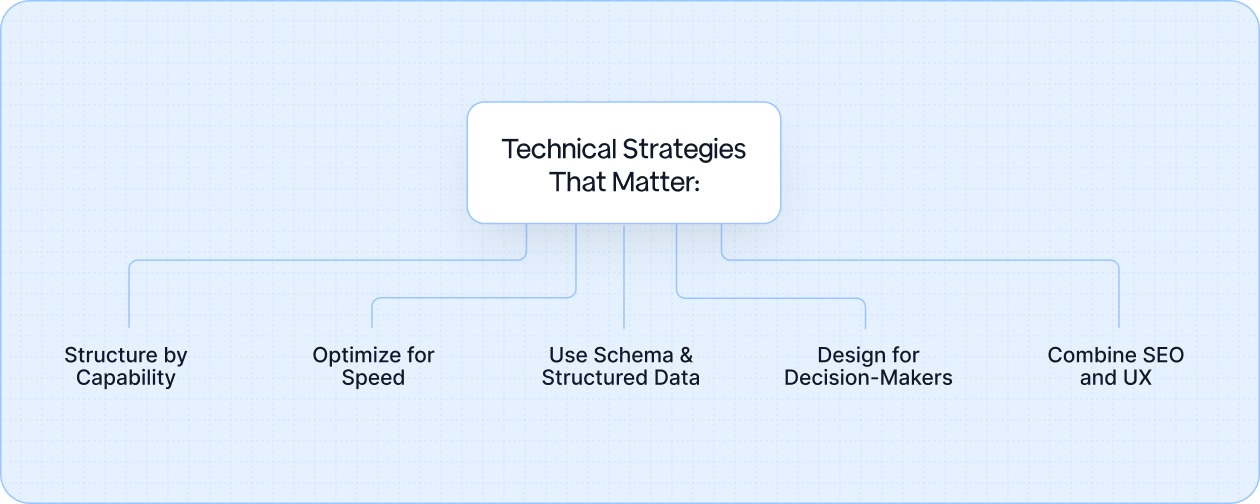
Technical strategies that matter:
Paid search works best for 3D printing businesses when it’s treated as a demand-capture channel. The goal is to intercept buyers who already know what they need and are actively comparing suppliers, timelines, and pricing.
Well-run PPC fills pipeline gaps, shortens sales cycles, and gives you control over lead flow while SEO compounds in the background.
How to approach PPC the right way:
This lowers lead volume but improves RFQ quality.
Social media is about credibility and familiarity. Buyers feel safer working with companies they’ve seen repeatedly doing real work.

Different platforms serve different purposes. Focus where your buyers spend time.
Email works best for 3D printing businesses when it supports long buying cycles, repeat production runs, and ongoing engineering conversations.
How to use email marketing effectively:
Referrals remain powerful in manufacturing and product environments. In many niches, being “the trusted name people recommend” outperforms ads.
These work when approached deliberately.
Focus on:
Partnerships compound over time, creating steady deal flow.
Strengthen this by:
In 3D printing, momentum beats perfection every time. The businesses that grow, get into the market early, learn from genuine buyers, and refine based on actual demand.
A website, positioning statement, or marketing funnel does not need to be flawless to start generating value. It needs to be visible, understandable, and usable.
Once you are live, improvement should be driven by usage.
Focus on:
Every iteration should remove friction from the buying process.
Many 3D printing businesses stall after initial traction by adding too many channels, tools, or initiatives at once. Complexity creates chaos and slows execution.
A more reliable scaling order entails:
When the basics are working, scaling becomes a matter of amplification. You increase volume, refine messaging, and expand channels only after the core system proves it can convert interest into revenue.
Basic marketing helps you get noticed. Advanced marketing helps you win real deals, shorten sales cycles, improve perceived expertise, and create predictable leads.

Below are advanced growth strategies top-performing 3D printing businesses use:
Most buyers don’t convert on their first visit. Retargeting keeps your brand visible during long cycles, so you’re not forgotten when they’re finally ready to request a quote.
3D printing buyers evaluate proof of competence. Video is one of the strongest ways to demonstrate capability because buyers can literally see workflows, machines, materials, and outputs as they would in a factory walkthrough.
Interest does not equal buying readiness. Many 3D printing leads go silent simply because nobody follows up consistently, or inquiries get lost when volume increases. A structured CRM and automated follow-up system ensures every lead is nurtured professionally.
Many 3D printing businesses want larger, repeat clients rather than one-off orders. ABM focuses marketing only on companies worth winning, so your efforts are precise and strategic.
In technical industries, decision-makers choose vendors who know what they’re talking about. Authority content, expert commentary, and visibility in credible industry platforms elevate your perceived expertise far beyond smaller competitors.
Marketing for a 3D printing business should be treated like a product iteration cycle: launch something measurable, learn from real buyers, and improve what matters.
If you walk away with one idea, let it be this: focus on making your best product story obvious and easy to buy. Do the basics, clear niche positioning, sales-ready content, and a simple follow-up flow, then build from steady wins. Small, consistent improvements beat occasional marketing spectacles every time.

Most gardening businesses spend their days outdoors solving very real, hands-on problems. Overgrown lawns, unhealthy soil, drainage issues, seasonal planting. Online marketing often feels abstract by comparison, disconnected from the actual work. As a result, SEO is either ignored or treated as a one-time checklist task.
But search engines don’t reward businesses for being online. They reward clarity. Clear services. Clear locations. Clear proof that you know what you’re doing. For gardening companies, SEO becomes less about promotion and more about translating real-world expertise into signals search engines can recognize and trust.
In this blog, we break down how SEO actually works for gardening businesses, from local visibility and seasonal keywords to content, technical foundations, and conversion tactics that turn search traffic into booked work.
Most gardening businesses already do good work. SEO decides whether that work compounds into steady inbound leads or stays invisible outside referrals.
Centrally, SEO turns your services, expertise, and past work into an always-on acquisition channel that works even when you’re not actively marketing.
Gardening, as a niche business, sits at the intersection of design, maintenance, and local conditions. Generic local SEO frameworks often fall short here.
Effective SEO for gardening needs to reflect that complexity.
SEO for gardening businesses works best when it mirrors how the work itself happens.
The strategies below focus on building visibility where homeowners actually look, earning trust before the first call, and turning search demand into booked jobs:
Gardening and landscaping services are inherently local. Customers' search is based on whether a provider understands local soil conditions, climate, and property types. Local SEO ensures your business appears where these decisions are actually made.
Key local SEO priorities include:
Local SEO has a few non-negotiable building blocks. If these are solid, every other effort works better.
For gardening, reviews are often the deciding factor. People want proof that you show up on time, protect their property, and leave things clean.
Keyword strategy determines whether your site attracts casual readers or real buyers. For gardeners, this means aligning keywords with seasonality, service intent, and local demand.
A strong keyword approach focuses on:

Every important service page can work with a small, focused keyword set rather than random phrases.
Short keywords like “gardener” bring mixed traffic. Longer phrases show clearer intent and often convert better.
On-page SEO is where most gardening websites quietly lose ground. Search engines read structure, clarity, and intent. Visitors read confidence, relevance, and ease.
Strong on-page optimization does both at the same time.
One overlooked factor is decision flow. A strong page guides the reader from recognition to reassurance without friction. That means structuring content around progression.
Here’s what that looks like in practice:
Effective on-page optimization for gardening SEO is about alignment.
Small technical details on each page affect how fast it loads and how easily it gets indexed.
Gardening SEO rewards consistency and usefulness more than volume. The goal is to become the site people return to when they’re unsure about a decision.
Blog posts and guides can drive traffic for years if they answer timeless questions.
Instead of random posts, build topic clusters so search engines see clear depth around your main services.
Video works very well for gardening, because people like seeing results and processes.
Search engines look beyond your site to decide whether it should rank. For gardening businesses, authority often comes from proximity, reputation, and industry alignment.
Not all backlinks help equally. Gardeners benefit most from links tied to real-world credibility.
You can build authority by sharing expert input where your audience already reads. You must try social media for that.
Technical SEO is like irrigation for your site. If it fails, nothing grows well, no matter how good the content is.
You want search engines to find, read, and index every important page quickly.
Google now measures key user experience metrics that influence rankings.
Schema markup adds extra tags to your HTML that explain what each page and section means. With correct schema, you can qualify for rich results like review stars, FAQ boxes, and better local panels.
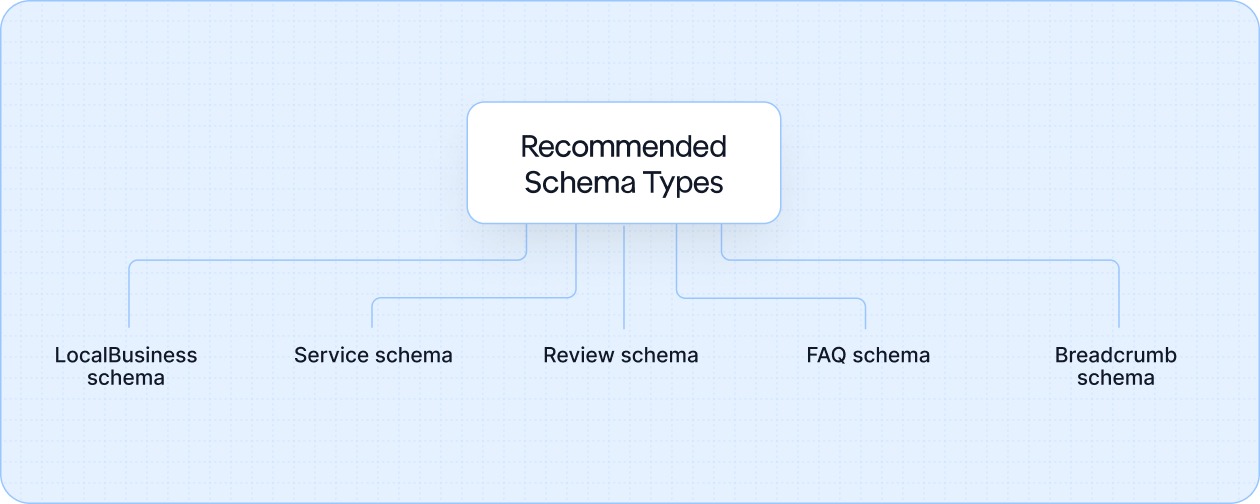
Focus on simple, high-impact schema first.
Crucial technical implementation can be:
SEO only works when it’s measured consistently.
Gardening SEO should be evaluated based on:
Start with free tools, then add more only if needed.
Once your basics run well, you can push for stronger authority and visibility.
You do not need to guess where you stand in your market.
Gardening is visual, which gives you an advantage.
Third-party trust badges help both visitors and search engines.
Gardening is not flat across the year. Search interest rises and falls with the seasons.
Plan content and promotion around predictable seasonal peaks.
Keywords do not stay constant. You should:
SEO brings visitors. Conversion optimization turns those visitors into booked jobs.
A good gardening page should make it very easy to decide and act.
Small tools can help catch visitors who would otherwise leave.
These strategies together give gardening businesses a clear, practical road map. You build visibility, authority, and trust step by step, then refine based on real data instead of guesswork.
SEO is powerful for gardening businesses, but it is not instant. It behaves more like growing a healthy garden than switching on a light. The more consistent, strategic, and patient you are, the stronger and more predictable the results become:
The first few months of SEO focus on building foundations: fixing technical issues, optimizing service and location pages, strengthening Google Business Profile, and creating useful content. During this stage, Google learns who you are, what you do, and whether you can be trusted to rank.
What typically happens in this phase:
This stage is about momentum. You may not dominate rankings yet, but you should feel clearer visibility and more qualified inquiries.
Once the basics stabilize and search engines consistently recognize your brand, SEO shifts from “getting noticed” to “becoming a trusted local authority.” This is where compounding benefits begin to take shape.
What businesses typically see in this window:
By this stage, SEO becomes a real revenue engine rather than a marketing experiment.
SEO should always be judged on business impact. Rankings matter, but only because they lead to profitable work. A realistic measurement mindset keeps decisions grounded.
What to track and expect:
In simple terms, SEO starts as visibility, matures into authority, and ends as a dependable source of ongoing work. With realistic expectations, disciplined execution, and patience, it becomes one of the most valuable long-term marketing assets a gardening business can build.
SEO for gardening isn’t a campaign you launch and move on from. It’s an operating system that quietly supports every part of your business. Your services become easier to understand. Your location becomes easier to trust. Your expertise becomes easier to find.
Once those foundations are in place, SEO stops feeling like marketing. It becomes infrastructure. Something that compounds as your reputation grows, your portfolio expands, and your local authority deepens.
The sooner it’s treated that way, the harder it becomes for competitors to catch up.

Running an industrial business with a small team and limited resources can make marketing feel like a major challenge. You want to connect with the right people, those who truly need your services, but high costs and complex strategies often get in the way.
Industrial lead magnets solve this problem. By offering something valuable in exchange for attention, you can start building relationships with potential customers who are already looking for solutions like yours.
This article will help you discover 11 practical lead magnet ideas that reach the right people and grow your business without the need for a big budget.
An industrial lead magnet is a targeted resource that helps SMBs in the industrial sector capture qualified leads by offering something valuable in exchange for their attention.
You need to provide a solution to a problem your potential customers face, making it easier for them to engage with your business.
These lead magnets can be:
By offering these resources, you not only attract the right prospects but also demonstrate your expertise, building trust along the way.
When it comes to attracting the right customers in the industrial space, lead magnets can be your most valuable tool. They help you provide immediate value and address the real needs of your target audience.
Here are 11 lead magnet ideas that can set you up for success, plus simple steps to create them.
An interactive tool that helps potential customers calculate their return on investment or savings when using your product or service.
How to create it:
To help industrial businesses understand the impact of your product or service, use this formula to calculate ROI:

Example: If you spend $5,000 on a piece of equipment that generates $7,500 in new revenue, your ROI would be 50%. Simple, actionable insights like this attract leads who are looking to make smart, data-driven decisions.
Case studies offer real-world examples that show the effectiveness of your solution and help build trust. They show your product's value and its tangible impact on your clients.
How to create it:
Why it works: Case studies demonstrate the real-world impact of your solutions, helping prospects connect the dots between their pain points and the benefits you offer. It's proof that your product works in scenarios similar to theirs.
Regulatory hurdles are a common challenge in industrial sectors. Offering checklists or templates helps businesses navigate compliance requirements easily, saving them time and avoiding errors.
How to create it:
Why it works: By offering downloadable and customizable resources, you position your business as a trusted advisor, and your lead magnet becomes a tool they can use immediately, helping you build strong relationships.
Buyers love a clear breakdown of how your product stacks up against competitors. A cost comparison calculator gives them a quick, visual way to see the advantages of your solution.
How to create it:
Why it works: A cost comparison calculator makes the decision process simpler, providing your prospects with a concrete reason to choose your solution based on value.
Engage prospects with live demonstrations and webinars that allow them to experience your product’s benefits firsthand and ask real-time questions.
How to create it:
Why it Works: Interactive learning experiences offer prospects a tangible understanding of your product and its benefits, fostering deeper trust.
Allow prospects to assess their current situation and provide personalized feedback or recommendations.
How to create it:
Why it works: These tools give your audience immediate value while positioning your brand as an expert who understands their specific challenges.
Continuous training is key in industrial sectors. Offering online training resources and certifications can position your business as a knowledge leader and add value to your clients’ workforce.
How to create it:
Why it works: Providing workforce training positions your brand as an expert in the field, while helping your clients stay competitive through skill development.
Providing valuable insights into industry trends and emerging technologies positions you as an authority. These reports help businesses stay informed and make smarter decisions.
How to create it:
Why it works: Research reports are an effective way to add value while demonstrating your expertise. Providing timely insights makes you a trusted source for critical industry knowledge.
Transparency is key in building trust. A virtual tour allows prospects to see your production process and quality standards firsthand, strengthening your credibility.
How to create it:
Why it works: A behind-the-scenes look builds trust and shows that your business values transparency and high-quality production, creating a stronger connection with prospects.
Networking and collaboration create valuable opportunities for professionals in your industry. Exclusive events help prospects connect with others facing similar challenges, fostering relationships that can turn into business.
How to create it:
Why it works: Networking events allow prospects to engage with industry peers, offering them real value beyond your product. This builds your reputation as a connector in the industry.
Position your business as forward-thinking by providing insights into new technologies and trends shaping the industry.
How to create it:
Why it works: This type of lead magnet keeps your audience informed about the future and demonstrates that you’re staying ahead of the curve, adding long-term value to your relationship.
SEO plays a crucial role in helping your lead magnet reach the right prospects at the right time. By applying the right strategies, you can make sure your valuable content is found and used by potential customers who need it.

Let’s dive into some simple yet effective SEO tips that will improve your lead magnet’s visibility and bring in the right audience:
The first step in optimizing your lead magnet is making sure it’s discoverable by the right people. By focusing on specific keywords that your ideal customers are searching for, you can get your lead magnet in front of them exactly when they need it.
How to do it:
Must Read: 8 Industrial Manufacturing Marketing Moves Most Ignore
If your landing page takes too long to load, potential customers will lose interest before they even get a chance to see your lead magnet. Page speed is a ranking factor for Google, so optimizing it improves user experience and helps with your search engine ranking.
How to do it:
Google loves content that provides real value to users. By offering actionable and relevant content that addresses the needs of your target audience, you increase your chances of ranking higher in search results.
How to do it:
With more people browsing on mobile devices, your lead magnet landing page must be mobile-friendly. Google also prioritizes mobile-first websites in its rankings.
How to do it:
If your industrial business serves a specific region, local SEO can be a game-changer. Make sure your lead magnet pages are optimized to show up for location-based searches.
How to do it:
Let’s look at a real-world example to see how these strategies work.

John Maye, a well-established packaging equipment supplier, was struggling with a lack of online visibility, despite their years of industry experience.
After implementing AI-powered SEO strategies, including optimizing their website for the right keywords and improving page speed, John Maye saw immediate results. In just 30 days, they generated 17 qualified leads, all from organic search.
What they did:
Building a successful lead magnet requires providing real value and solving the specific problems of your target audience.
By following the tips we’ve covered, you can create a resource that captures attention and helps you build lasting relationships with your ideal prospects.
Here’s a quick recap to guide your lead magnet creation journey:
To create your lead magnet, remember that it's important to start conversations and build trust, which requires expert help and guidance. It could be a valuable guide, a case study, or an interactive tool; offering something of real worth will set you apart.

You’re out there, chainsaw in hand, turning your passion for tree care into a thriving business. You know your craft, but getting the right people to notice you can be a whole different challenge. Tree service marketing requires you to ensure your business is the first one people think of when they need help.
Neighbors in need of routine pruning and property managers with bigger projects will find your name when the right marketing strategy is in place.
Let’s break down the simple steps you can take to get your business in front of more potential clients.
A strong marketing strategy is the backbone of any successful tree service business. Without a clear plan, you risk wasting valuable time and resources.
Setting clear goals, understanding your target market, and measuring ROI ensure your efforts are calculated to bring consistent growth.

It’s time to focus on the basics. Here are quick steps to ensure your marketing efforts are headed in the right direction:
Branding is your first opportunity to show potential clients that you’re trustworthy and professional. Your brand speaks before you do. It's the first impression your clients will have.
Local SEO is essential for ensuring that your business shows up when people search for tree services in your area. Without it, you might be invisible to potential customers.
Must Read: Landscaping SEO Made Easy: 15 Steps to Improve Visibility and Get More Calls
Content marketing helps you build credibility and provide value to your customers. Through informative content, you become an authority in tree care, which naturally attracts clients.

This not only demonstrates your expertise but also builds trust with potential clients who may need your services.
Use real-life examples and explain how your solutions can restore safety and aesthetics to their property.
Be sure to include customer feedback or testimonials alongside the images to build credibility.
You could also show the process of tree removal or stump grinding to give potential clients an idea of what to expect.
Share Seasonal Reminders and Alerts: Help your audience stay on top of important tree care tasks with seasonal reminders. For example, in the fall, share tips on preparing trees for winter weather or cleaning up fallen leaves to prevent pests. This positions your business as an ongoing resource, not just a one-time service provider.
Social media is a great way to connect with your community, showcase your work, and interact with potential customers.
Must Read: Your Social Media Marketing for Landscaping and Lawn Care is Slacking - Let’s Fix That
Paid ads can quickly get your business in front of the right people, especially when you're in a pinch or need extra visibility.
Satisfied clients are your best marketers. Creating a simple system for collecting reviews and encouraging referrals can lead to a steady stream of new business.
Even in a digital world, traditional marketing methods still play a key role in local visibility and brand awareness.
A well-run operation is crucial for growth. Equip your team with the right skills and establish credibility within your industry.
Becoming a member of professional organizations such as the Tree Care Industry Association (TCIA) and the International Society of Arboriculture (ISA) demonstrates your commitment to industry best practices and professionalism.
These certifications add credibility to your business and assure customers that they are working with trusted experts.
Additionally, getting Certified Treecare Safety Professional (CTSP) accreditation ensures that safety is always a priority.
Many areas require specific certifications for tree care services, like pest management or tree removal. Being compliant with local or state certifications can further set you apart from the competition.
Having these certifications and memberships elevates your business's profile and provides opportunities for continued education, networking, and growth.
Partnerships with other local businesses can provide a valuable source of leads and grow your network.
You've learned the most effective marketing strategies, and now it's time to take action. With the right approach, you'll see your business grow in no time.

You've got the equipment, the experience, and the drive to serve the mining industry, but when people search online, your business is nowhere to be found. Frustrating, right?
SEO for mining equipment manufacturing is the key to making sure your company shows up when potential customers are looking for the equipment you provide. You just need simple, smart steps to help people find you at the right time.
If you're ready to get your business in front of the right audience, SEO is the tool that'll make it happen. Let's explore how these strategies can connect your company with the people who need your products most.
SEO plays a crucial role in helping mining equipment manufacturers stand out in a crowded market. As competition intensifies, businesses must adapt to digital strategies that attract the right customers at the right time.
Here’s how SEO helps mining companies gain visibility and stay competitive:
The majority of customers now begin their search for mining equipment online. If your business isn’t easily found, you're missing out on valuable opportunities. SEO ensures your business shows up in relevant search results, increasing the chances of connecting with potential customers when they need you most.
For SMBs, budget constraints are a constant challenge. However, SEO offers an affordable way to target the right customers. By optimizing your website, you ensure that your marketing dollars work harder, driving traffic from those actively seeking your services.
In a market where companies are vying for attention, SEO provides a clear competitive advantage. Well-executed SEO increases your site’s visibility and helps build customer trust. The more you rank, the more likely potential clients are to choose your business over the competition.
Mining equipment manufacturers must pivot from traditional marketing strategies to digital methods to stay competitive. SEO is a vital tool for connecting with customers who rely on online search to make decisions.
Traditional marketing tactics like trade shows and print ads still have their place, but they no longer offer the reach or cost-effectiveness of digital marketing. SEO connects your business with a broader audience, allowing you to stay visible 24/7, even when customers aren’t actively looking for you.
One of the key benefits of digital marketing is its ability to reach a large audience at a fraction of the cost of traditional methods. SEO allows mining equipment manufacturers to connect with customers who are already searching for their products, enabling targeted marketing with a minimal budget.
Scaling a small or medium-sized business can be a challenge, especially when competing with larger companies. SEO is an equalizer that allows SMBs to improve visibility and compete effectively in the market without large advertising budgets.
In an industry as specialized as mining equipment manufacturing, building online visibility is crucial. SEO helps position your business as the trusted choice when potential customers search for equipment.
Here’s how SEO can enhance your online presence:
Trust is key in the mining equipment business. SEO helps you build credibility by improving your site’s authority and ensuring that potential customers see your business as reliable and professional.
Must Read: Implement 2 of 5 Sales Enablement Ideas to Beat Old-School Manufacturing Competition
As an SMB, every marketing dollar counts. SEO allows you to target specific leads without the need for expensive ads, ensuring that your business is visible to the right audience at the right time.
By using these strategies, mining equipment manufacturers can grow their online visibility without blowing their budget.
Mining equipment manufacturers must adopt smart, effective SEO strategies to ensure the right audience sees them. The right SEO tactics make it easier for customers to find your business and drive long-term success without requiring an extensive marketing budget.
Let’s break down some of the most crucial strategies that will help you stand out and attract quality leads.
Effective keyword research is foundational to any SEO strategy. For mining equipment manufacturers, it’s crucial to focus on industry-specific terms that reflect the unique needs of your customers. Here's a more in-depth look at how to approach this:
Your target audience is searching for very specific equipment, parts, or services. Instead of going after generic terms, focus on long-tail keywords and niche terms that align with the mining industry.
For example, use terms like "mining equipment for hard rock mining" or "heavy-duty excavators for surface mining". These keywords are more likely to attract qualified leads who are looking for exactly what you offer.
Search intent is critical for keyword research. Are potential customers looking for information, product comparison, or to make a purchase? Conduct research around commercial intent keywords like "buy mining drills" or informational intent like "how to maintain mining equipment."
Understanding these differences will allow you to tailor your content and optimize for the right types of searches.
Tools like Google Keyword Planner, Ahrefs, and SEMrush can help you discover high-value keywords and track how competitive they are.
Start with broad mining equipment terms, then narrow them down using these tools to identify low-competition, high-conversion keywords specific to your offerings.
On-page SEO is about creating an experience that’s both search-engine and user-friendly. To make your product pages and technical specs really stand out, here are some in-depth techniques for on-page optimization:
Start with clear, well-structured product descriptions that include the most relevant keywords. Don’t just list features; explain how the product solves problems for your customers.
Incorporate high-quality images, technical specifications, and even videos to improve user engagement and retention. Be sure to add keywords naturally in the headers, meta descriptions, and product features.
Internal linking helps search engines understand the structure of your website and establishes authority within your site. Link related products, blogs, and case studies within your pages to guide visitors and keep them on your site longer.
For example, if you sell drilling equipment, link to related case studies or how-to guides on equipment maintenance.
Ensure that all pages are optimized for fast load times and are mobile-friendly. Use tools like Google’s PageSpeed Insights to analyze load times and implement improvements.
Additionally, make your site easier to navigate by simplifying your site architecture with clear, concise menus and a logical page hierarchy.
For mining equipment manufacturers targeting remote areas, optimizing your website to function smoothly even in low-connectivity regions is essential. This requires both technical and performance-focused SEO:
Website speed is critical in areas with limited internet connectivity. Compress large images, minimize JavaScript, and ensure you're using fast hosting services. Tools like GTmetrix can help you analyze your site speed and recommend improvements.
With many users in remote areas relying on mobile devices to browse, having a mobile-optimized website is essential. Ensure your website design is responsive and that all content, images, and videos load correctly on mobile devices.
Google prioritizes mobile-friendly sites in search results, making it a win-win for both user experience and SEO.
Ensure your site doesn’t rely on heavy elements that might cause slow load times, such as large images or complex interactive features. Focus on text-based content, optimized images, and lightweight HTML to reduce page load times without sacrificing important content.
For remote regions, target geo-specific keywords that focus on mining areas or regions where mining equipment is in demand. This helps your business appear in searches relevant to the local mining operations, even when those areas have slower internet speeds.
Tools like Google Search Console and Google My Business can help monitor and improve local SEO efforts.
Must Read: 8 Industrial Manufacturing Marketing Moves Most Ignore
Creating content that resonates with your audience is at the heart of a successful SEO strategy. When your content directly addresses your customers’ challenges, it attracts them to your website and builds trust.
Valuable content helps position your business as an authority in the mining equipment field. Focus on creating informative articles, how-tos, and industry insights that cater to your audience's needs.
Offering educational resources like product guides, maintenance tips, or troubleshooting advice helps build credibility. Customers appreciate content that helps them make informed decisions.
Distribute your content on platforms like LinkedIn, YouTube, and Instagram to engage with a broader audience. Each platform has its own strengths, so personalize your content accordingly to connect with users effectively.
Local SEO is a vital part of any strategy for businesses that cater to specific regions or serve local communities. By optimizing for local search, your mining equipment business can stand out in its target area and increase foot traffic or service inquiries.
Ensure your Google Business Profile and Apple Business Connect profiles are complete and up-to-date, allowing local customers to find your business quickly.
Implementing location-based keywords helps you target customers in specific regions. These keywords drive traffic from searches for mining equipment in your service areas.
Make sure your business’s NAP is consistent across all directories and platforms. This consistency helps improve your local search rankings and builds trust with both search engines and customers.
Encourage customers to leave positive reviews. Reviews help build local credibility and can also improve your rankings in local search results.
While SEO builds long-term results, PPC (Pay-Per-Click) advertising can help you get immediate visibility for high-priority keywords. By using PPC alongside SEO, you can capture leads in the short term while working toward sustained success.
PPC campaigns can immediately place your business at the top of search results for your target keywords, offering quick visibility as your organic SEO efforts build over time.
Focus your ads on high-intent keywords that align with customer needs. Create your PPC campaigns to reach leads who are ready to take action, increasing the likelihood of converting them into customers.
Ensure that your PPC landing pages are designed to convert visitors. They should be clean, simple, and focused on the CTA, offering exactly what the ad promised.
Tracking your progress is key to ensuring that your SEO efforts are paying off. Without data, it’s difficult to determine which areas need improvement.
Track key metrics like organic traffic, keyword rankings, and user behavior to understand which strategies are working and where adjustments are needed.
Monitor what actions visitors are taking on your site, such as filling out a form, making a purchase, or requesting a quote. These actions help you gauge the effectiveness of your SEO strategy.
Search engines constantly evolve, and so should your SEO strategy. Regularly assess and adapt to keep up with changes and stay ahead of the competition.
A well-optimized website is the cornerstone of any successful SEO strategy. Here’s how to ensure your website is working hard for you:
Ensure your website loads quickly and is mobile-friendly. Google rewards fast websites with higher rankings, and customers expect a seamless experience on all devices.
A simple, user-friendly design helps keep visitors engaged and ensures they can easily find the information they need. This improves your site’s SEO and lowers bounce rates.
Must Read: We Analyzed 25+ Top Manufacturing Websites - The Winners Follow These Simple Steps
As your business grows, so should your SEO efforts. You may need to bring in experts to scale your content and SEO strategy effectively.
Recognize when your internal efforts need an upgrade. An expert partner can provide the insights and resources needed to take your SEO strategy to the next level.
Look for agencies or experts who understand your industry, have a track record of success, and are aligned with your business goals. They’ll help scale your SEO efforts to meet growing demand.
SEO is the key to getting your mining equipment business seen by the right people. It increases your visibility, connects you with customers, and puts you ahead of competitors. From targeted keywords to creating valuable content, each strategy helps you build a strong online presence that lasts.
Remember, SEO is an ongoing process. If you're ready to dive in yourself or need expert help to make the most of it, the next step is up to you.

When you're running a small pest control business, the flood of leads can be both exciting and overwhelming. The trick is figuring out which of these potential customers are actually looking for your help right now, and which ones might not be the right fit.
Pest control service lead scoring helps you sort through this mix by assigning a score to each lead based on its potential to convert into a paying customer.
By focusing on leads that are most likely to need your services, you can save time, energy, and resources, ensuring you’re reaching the right opportunities.
Lead scoring is a system used to evaluate potential customers based on how likely they are to book your services. It assigns a score to each lead, helping you prioritize the most promising prospects.
Lead scoring works best when paired with optimized lead generation forms. These forms capture the critical details needed to assess a lead’s value, such as the type of pest, urgency, and location. By integrating these forms with your lead scoring system, you ensure the most relevant data is used to prioritize prospects."

In pest control, time is often critical. Many customers face urgent pest problems that need immediate attention. Lead scoring allows you to:
Optimizing your lead generation forms is a great way to support your lead scoring efforts. Well-designed forms ensure you gather accurate information that allows for more effective scoring, helping you to act on the most urgent leads first.
For example, if a lead’s form response indicates a termite infestation, you can score that lead higher due to its urgency.
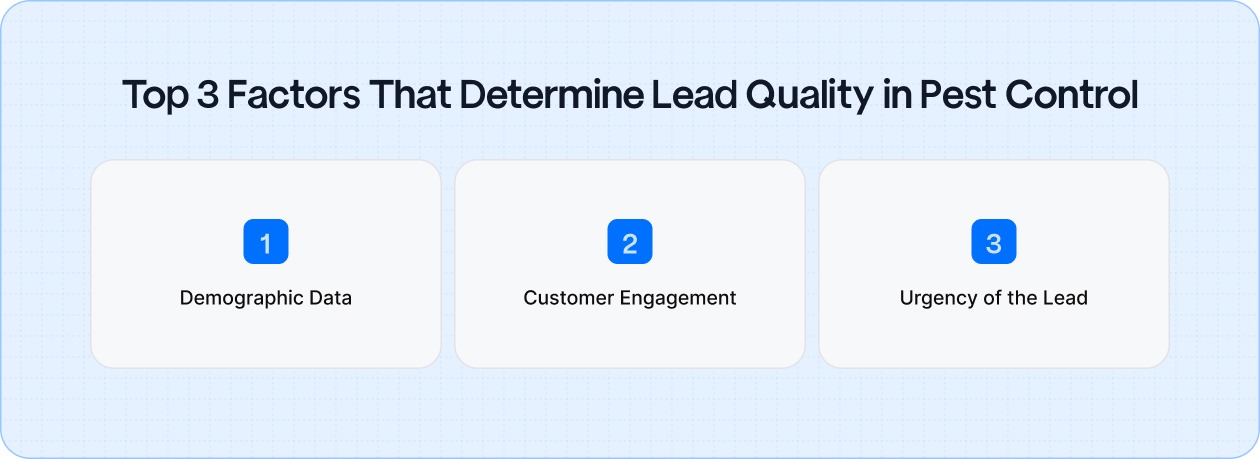
To make the most out of your pest control leads, it’s essential to understand the factors that determine their quality. Here’s a breakdown of the key elements to watch for when evaluating leads:
Understanding your lead’s background can tell you how likely they are to convert. Key factors include:
How a lead interacts with your website and content can indicate how serious they are. Consider:
The quicker the issue, the higher the chance of a sale. Key points to evaluate:
Urgency-Based Scoring: Emergency pest issues should be prioritized over routine services.
For example, a rat infestation requires immediate attention, making these leads more likely to convert rapidly compared to non-urgent inquiries, like scheduled inspections.
The data captured in your lead generation forms directly ties into each of these factors. For instance, form fields asking for pest type, urgency, and location enable you to categorize leads accurately and assign appropriate scores based on their likelihood to convert. These forms act as a key input in determining the quality of the lead.
Must Read: 11 Proven SEO Strategies for Home Services to Increase Calls and Leads
Setting up lead scoring for your pest control business can streamline your sales process and help you focus on the leads most likely to convert. Here’s a simple step-by-step guide to getting started:
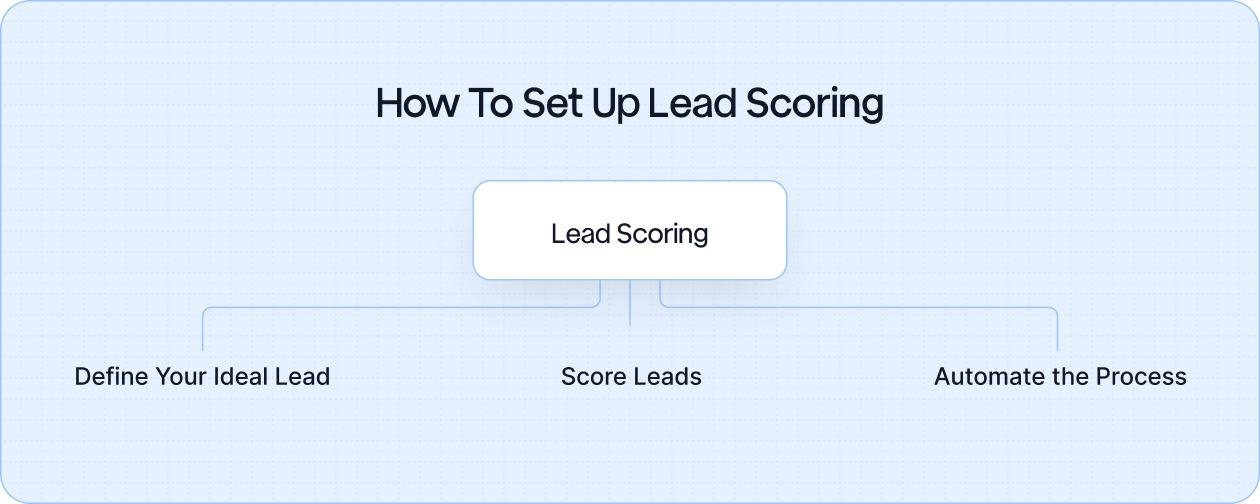
Understanding who your best customers are is the foundation of lead scoring. Start by creating buyer personas that outline the key characteristics of these high-value leads. Consider:
As part of defining your ideal lead, focus on how your lead generation forms capture key data. Consider creating custom fields that capture the urgency of the pest issue and location, ensuring your forms directly contribute to the lead scoring process.
Once you know what makes a lead valuable, it’s time to set the rules. Your lead scoring system should be based on factors that indicate how likely the lead is to convert:
When assigning scores, make sure to integrate data from your lead generation forms, e.g., a lead with a form indicating a serious rodent problem should automatically get a higher score than one requesting routine pest control.
Automating the form submission process ensures data is captured and fed directly into your lead scoring system. This not only saves time but also ensures accuracy in scoring, making sure high-priority leads are prioritized instantly
This automation means you don’t have to waste time manually sorting through leads; your system does it for you as soon as they come in.
For small and medium-sized pest control businesses, technology is a powerful ally in optimizing lead scoring. With the right tools, businesses can automate processes, predict outcomes, and improve efficiency, all while saving time and resources.
Here's how technology is transforming lead scoring for SMB pest control companies.
AI and machine learning can significantly enhance the accuracy of lead scoring. By analyzing historical data, AI predicts which leads are most likely to convert, ensuring your team focuses on the highest-value prospects. This predictive analytics model helps SMBs to:
With AI, pest control companies can make smarter decisions faster, improving overall sales efficiency.
Integrating lead scoring with a CRM like Zoho or HubSpot ensures seamless communication between your sales and marketing teams. These tools allow businesses to:
CRM tools simplify lead management, making it easier for SMB pest control businesses to stay organized and responsive without manual tracking.
For SMBs with limited resources, cost-effective automation is key. Many CRM platforms offer affordable solutions that allow businesses to implement lead scoring without needing a large team. These benefits include:
Technology-driven solutions like CRMs integrate seamlessly with your lead generation forms. By automating data capture and scoring based on form submissions, you can instantly assign lead scores, which helps in streamlining decision-making and increasing your conversion rates.
To make the most out of your lead scoring system, it’s essential to implement practices that ensure its effectiveness over time. Without proper setup and ongoing refinement, lead scoring can miss valuable opportunities.

Here are the best practices for creating a robust and efficient lead scoring system:
The foundation of effective lead scoring lies in the quality of the data you collect. Consistency is key when gathering data across all customer touchpoints. If a lead interacts with your website, calls in for an inquiry, or fills out a form, make sure you track and organize all actions.
Each lead’s journey should be seamlessly recorded to ensure that no key information is overlooked.
Ensure that your lead generation forms are consistent across all customer touchpoints. Whether a lead comes through your website, social media, or a phone call, the form responses should be uniform, helping to streamline data collection and improve scoring consistency.
Lead scoring requires constant refinement. As your business grows and evolves, so should your lead scoring system. Regularly assess how well your lead scoring is performing by reviewing the outcomes of past leads and adjusting your criteria. What worked for one batch of leads may not work as effectively for the next.
Regularly assess your lead generation forms to ensure they are collecting the right data. For example, if your current forms don’t capture urgency effectively, refining them to include a checkbox for ‘immediate service needed’ will help prioritize urgent leads.
Effective lead scoring ensures that your sales and marketing teams are working in sync. If these teams aren’t aligned on what defines a high-quality lead, the system will falter. Both teams should use the same criteria to evaluate leads, ensuring seamless handoff and follow-up.
Ensure both teams use the same set of lead generation forms with clearly defined fields that are aligned with your lead scoring model. This will create seamless handoffs from marketing to sales, ensuring high-value leads get immediate attention.
Must Read: 15 Smart Marketing Moves to Drive Growth for Your Home Services Business
Track how your lead generation forms are performing in terms of capturing high-quality data. By analyzing form submission patterns, you can identify which fields most accurately predict conversions, allowing you to refine your lead scoring model and focus on the right prospects.
Here’s how to effectively evaluate the success of your lead scoring system:

If the leads with the highest scores consistently convert, it’s a sign that your scoring system is on track.
If this ratio is skewed towards low-quality leads, it may be time to adjust your lead scoring criteria.
This will help you refine your criteria, ensuring that your system adapts as market conditions or customer behaviors change.
A successful lead scoring system is built on continuous improvement. To ensure you're making the most of your efforts:
If certain lead behaviors predict higher conversion rates, adjust your system to prioritize these actions.
Lead scoring is a powerful tool for SMB pest control businesses, enabling them to focus on high-value leads and improve conversion rates while using minimal resources. By prioritizing the right prospects, you can make your sales process more efficient and drive growth without needing a large team.
To maximize the effectiveness of your lead management, pair lead scoring with optimized lead generation forms. By capturing detailed data and automatically scoring leads, you ensure your team is focusing on the most promising prospects, streamlining your sales process and accelerating business growth.





.svg)
.svg)
.svg)